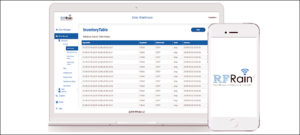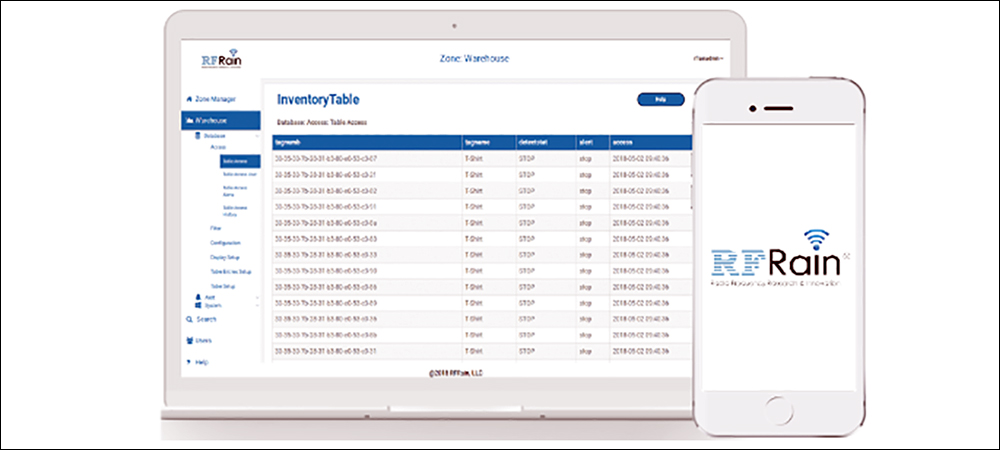Technology company RFRain has released the latest version of its Web Services solution to enable the easy deployment of RFID with little technical know-how, so that users can manage read data in the cloud, as well as link it to sensor-based information. The company’s RFRain Web Services (RWS) solution includes its Zone Manager Rest application programming interface (API), Zone Manager Enterprise and Zone Manager Asset management software, as well as a software developers kit (SDK). This allows users to read tags, receive alerts and push notifications, and view data in real time or historically, without installing software, middleware or reader firmware.
Thus far, the solution is being used by companies that require a cloud-based view into the status of assets at numerous or remote locations, including warehouses, retailers, and healthcare, avionics and energy companies. RWS was available throughout the past year and a half for those using RFRain readers. Now, thanks to the SDK and API, users can capture and manage RFID reader data with hardware from other vendors. The company demonstrated and promoted the solution at the recent RFID Journal Virtually LIVE! conference.

To meet the needs of companies utilizing the system, RFRain has enabled RWS to capture not only the unique ID number of each tag, but also visuals (assuming a camera is employed), in order to link images or video footage of specific events to a particular read event, as well as GPS data for outdoor applications. For businesses looking to access intelligence regarding their assets or inventory, RFID solutions have been out of reach due to the cost and complexity of deployments, according to Danny Akaoui, RFRain’s founder and CEO.
For RFID use, Akaoui explains, “You need to buy hardware [and] firmware, store data through another software application on premise, then another software application to store in the cloud.” With common hosting services such as AWS or Microsoft Azure, he adds, users pay for data per access. “What we’re doing is providing the ability to have data automatically on the cloud without having to worry about the network infrastructure.” The service is provided for a monthly fee, he notes, rather than on a per-access basis.
“From a technical perspective,” Akaoui says, “I started the company when I realized how complex it was to build an infrastructure.” RFRain sells UHF RFID plug-and-play readers and antennas, as well as the cloud-based software to manage the collected data, such as its Zone Manager and Zone Manager Enterprise offerings. The company’s customers include healthcare firms seeking to manage medical equipment and other assets at multiple hospitals, as well as retailers that need to access inventory data in real time at various stores.
Recently, Akaoui says, some companies have required support beyond capturing RFID data—they wish to collect location information based on GPS, along with video captured in the cloud. The solution enables the filtering of data and push notifications, he adds. For instance, a user can set the system to issue an alert if an asset changes location. “They don’t need to know an asset was detected 200,000 times a day,” he explains. “They need to know when an asset was moved, and that’s what our push notification can provide,” when used with the system’s filtering capability.
To deploy a new system, RFRain says it would plug in the reader and connect it to the cloud via a user interface, after which a few hours of simple programming would be necessary. The company partners with systems integrators that can provide services such as antenna positioning and proper power level setup for the required read range. The reader forwards data filtered in the cloud, then RWS interprets that information and pushes it to a software application from SAP or another provider.
Zone Manager Enterprise allows a user to access the data on dashboards, manage the status of each device, send data to devices and set up alerts. For example, a consumer goods retailer is using the technology to track inventory leaving its multiple stores. It can do this with only readers deployed at each site, Akaoui says, and no IT equipment. The reader installed at the exit captures the unique ID encoded on a UHF RFID tag, such as on a product’s price label, then forwards that data directly to the cloud. The system can send e-mail alerts that products are leaving the store, which the retailer can then order. This data enables the company to avoid out-of-stocks.
According to Akaoui, a healthcare company is employing the solution to understand when assets are removed from storage or from a hospital. By linking tag-read data with camera video recordings, he explains, “They have video of that event if they need it,” rather than having to search through many hours of footage to determine what occurred when an item was removed. Users can simply click on a prompt in the software to view video associated with a specified tag read.

RFRain’s Danny Akaoui
GPS information is being used with RFID tag reads when handheld readers are employed to capture tag data in the field. For instance, if someone is reading the tags on tools or assets deployed at remote locations, each item’s longitude and latitude location is captured by the handheld with every tag read, and the measurements are stored along with the read data. That data is then sent automatically to the cloud, provided that the reader has Wi-Fi access. If not, the data will be stored in the handheld, and then be synched to the cloud once it regains Wi-F connectivity.
In addition, the solution enables the collection of other sensor data, such as temperature or humidity readings, which can be linked to a particular RFID tag ID. The RWS system provides users with data such as the status of hardware, Akaoui says, and also enables the RFRain hardware to be upgraded on the handheld device. The information can be stored on a local server for those who do not opt to use the cloud. “Without changing the communication stack,” he states, “we can provide the software locally on a server, the same way it would be provided in the cloud.”
The system can be set to capture data every 15 seconds or less frequently, and it comes with the option of searching for historical data by providing a choice of data-mining functions. For instance, a user could search how many times a given asset was found at a specific location, which would indicate how often it was washed or maintained, or when it entered an unauthorized area or was moved when it should not have been. The software also associates parent and child tags if, for instance, tagged products must be linked to another item, such as a cart on which those objects should be loaded.
In addition to healthcare and retail companies, customers using the RWS system include logistics, manufacturing and aviation firms, Akaoui reports. The RWS currently costs $119 a month. Recently, the company released its RFR-RAIN-1-handheld reader, which comes with its Zone Manager Mobile software preinstalled.


